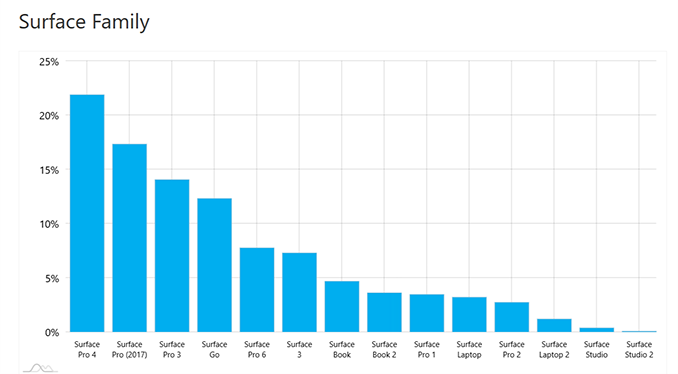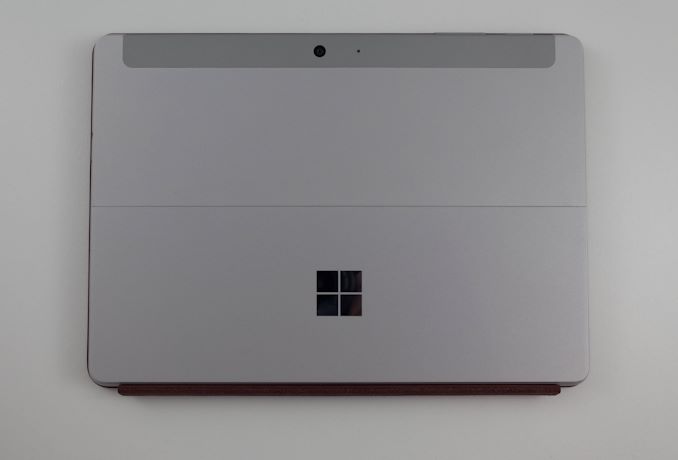The Microsoft Surface Go LTE Review: Unmatched Mobility
by Brett Howse on January 17, 2019 8:00 AM ESTFinal Words
The Surface Go sits in a somewhat interesting segment of the market. The base model has a price that’s low enough to be considered a value proposition, but like all value devices, there’s compromise to get there. The $399 starting price includes just 4 GB of RAM, and 64 GB of eMMC storage, which is outright the bare minimum that would even be usable with Windows 10. Microsoft now offers a 4 GB model with the 128 GB SSD for $499, which is already a price that’s creeping out of the value segment. 8 GB of RAM is $549, which is a lot for a low-end device. If you want to add LTE, the price starts at $679 with 8 GB of RAM and 128 GB of storage, and business customers will be able to purchase a 256 GB model as well. Then you must add in the price of the Type Cover, which starts at $99, and is realistically a required accessory.
A model with 8 GB of RAM and the Type Cover is therefore about $650, or a bit more if you choose a Signature Type Cover. That’s a lot more than the $399 get-you-in-the-door price, and really moves the Surface Go up a couple of rungs on the pricing ladder.
But the Surface Go does have some very good qualities going for it. The build quality is certainly a step above anything else in this price range on the PC side, with a fantastic magnesium body, a built-in kickstand which is every bit as good as the Surface Pro’s, and a very light weight. Even with the Type Cover attached, the device still only weighs 767 grams, or about 1.7 lbs, and coupled with the small size, makes the Surface Go extremely portable. Add in the fact that it works with the Surface Pen, and you can see an easy use case in a small, but expensive, note taking machine.
Microsoft also color calibrates all of its displays, and you would be hard pressed to find anything else in the PC space at this price range with as accurate of a display. The Go’s display isn’t the highest density one around, but at 216 pixels-per-inch, it still offers great clarity, and good contrast as well. Microsoft offers better displays on some of its other devices, but this is still a high quality display and very pleasing to use.
However, there’s some drawbacks as well. At the introductory price of $399, the underwhelming performance fits in with much of the competition, where Intel’s Atom is the name of the game. Despite Microsoft moving to a Core-based Pentium in the Surface Go, it’s disappointing to see where it stacks up: more or less even in terms of CPU performance with Intel’s latest Atom processor. At $399, that’s kind of expected, but since most people should buy the model with 8 GB of RAM, and a Type Cover, all of a sudden the Pentium Gold kind of looks out of place in a $650 PC. The performance is well above the previous non-Pro Surface 3 tablet, but the expectations have also progressed.
We’ve already touched on this, but this is a tough spot in the market for companies to try to launch quality devices for less money. Intel has a stranglehold on the market, and has taken the stance that Core branded products are sacred. Its margins must be protected. AMD doesn’t really offer anything that would compete in terms of power usage, and Qualcomm doesn’t offer anything in terms of performance. If Intel offered even a modest amount of Turbo on the Pentium Gold range, it would help tremendously, but they don’t. It’s an unfortunate spot to be in today.
The other real drawback is the battery life, which really comes down to battery capacity. At 27 Wh, there’s just no way the Surface Go can ever really be expected to provide a full day of work out of a single charge, and on a device this portable, that’s a drawback. This is why it is great to see USB-C on the Surface Go. Microsoft has never really supported this connector, but if there was a single device where it makes sense, it is this one. The Surface Connect charger is a convenient method of magnetically connecting a charger on your desk, but being able to charge off of a USB-C charger slightly mitigates the battery concerns, and would even allow a power back to be attached if necessary.
What was a great move though was coming out with this LTE model. Yes, you can always tether a laptop to a phone’s cellular connection over Wi-Fi, but for those that need something that’s always connected, that’s not the ideal solution. Having built-in LTE really expands the use cases for the Surface Go, especially in business. Having employees being able to be mobile, but still being able to manage their PCs, is an appealing draw. This is definitely not a feature everyone needs, and the $130 price increase, plus the monthly data fee, strikes that point home. But for those that need it, this is invaluable.

Source: AdDuplex.com
Despite the performance and battery life, Surface Go looks to be a bit of a hit, with a usage share already higher than many Surface devices that have been on the market longer. Clearly the small size and good build quality is something people are looking for. Adding LTE to that increases the mobility further, and although Microsoft likely won’t sell more LTE models than WI-FI, it definitely increases the potential market. And, despite the Surface Go being priced at a premium for a small form factor convertible tablet, it is still priced well under the entry level Surface Pro 6. The Pro 6 offers much higher performance, a bigger, nicer display, better battery life, and a keyboard that doesn’t feel cramped. But the Surface Go is smaller, lighter, and less expensive. With already 12% of the Surface usage share, that appears to be a winning formula.













79 Comments
View All Comments
eastcoast_pete - Thursday, January 17, 2019 - link
Independent of this or other LTE-enabled tablet, laptop or 2-in-1s, there is a major obstacle that has hog-tied the entire concept of always-connected computing: the ridiculously overpriced LTE data plans. At least in the US, a one year data plan with actually usable data limits can easily be more than this Surface fully decked out. That's why 5G is really not that interesting; even if it is as speedy as its proponents promise, it just means that we can now blow through a whole month of data allotment in less than one battery charge. Until data plan pricing comes down a lot, these otherwise enticing always-connected devices will remain niche products.The_Assimilator - Friday, January 18, 2019 - link
Y'all need to fix your oligarchy.ads295 - Saturday, January 19, 2019 - link
So true. Just prepaid for unlimited calls, texts and 1.5GB data a day (unlimited after but throttled). Paid about USD 23.ads295 - Saturday, January 19, 2019 - link
That's for a yearly plan btw.Gunbuster - Monday, January 21, 2019 - link
Whats the real sales pitch for always connected again? Super road warriors already have this figured out with phone or MiFi type hot spot so you are trying to sell to a niche within a niche...damianrobertjones - Monday, January 28, 2019 - link
This still doesn't stop people going on and on and on and on and on about the Surface 'Pro' line not having lte.DillholeMcRib - Thursday, January 17, 2019 - link
I really hope Microsoft gets off the Intel Kool-Aid soon and switches to AMD. They could offer a cheaper device with better graphics performance.And, also, I hope they finally get Windows on ARM to a level where emulation is not such a downer, as I would buy one of those straight up for the right price.
TheinsanegamerN - Thursday, January 17, 2019 - link
Given how poorly the Go already fares in the battery life department, and how much worse ryzen mobile has been on battery life, I wouldnt hold my breath anytime soon.The_Assimilator - Friday, January 18, 2019 - link
> I really hope Microsoft gets off the Intel Kool-Aid soon and switches to AMD. They could offer a cheaper device with better graphics performance.The only one drinking Kool-Aid here is you, because AMD doesn't have any CPU at this level of low power consumption.
HStewart - Saturday, January 19, 2019 - link
Keep dreaming - with Sunny Cove around the corner. On both AMD and ARM fronts.